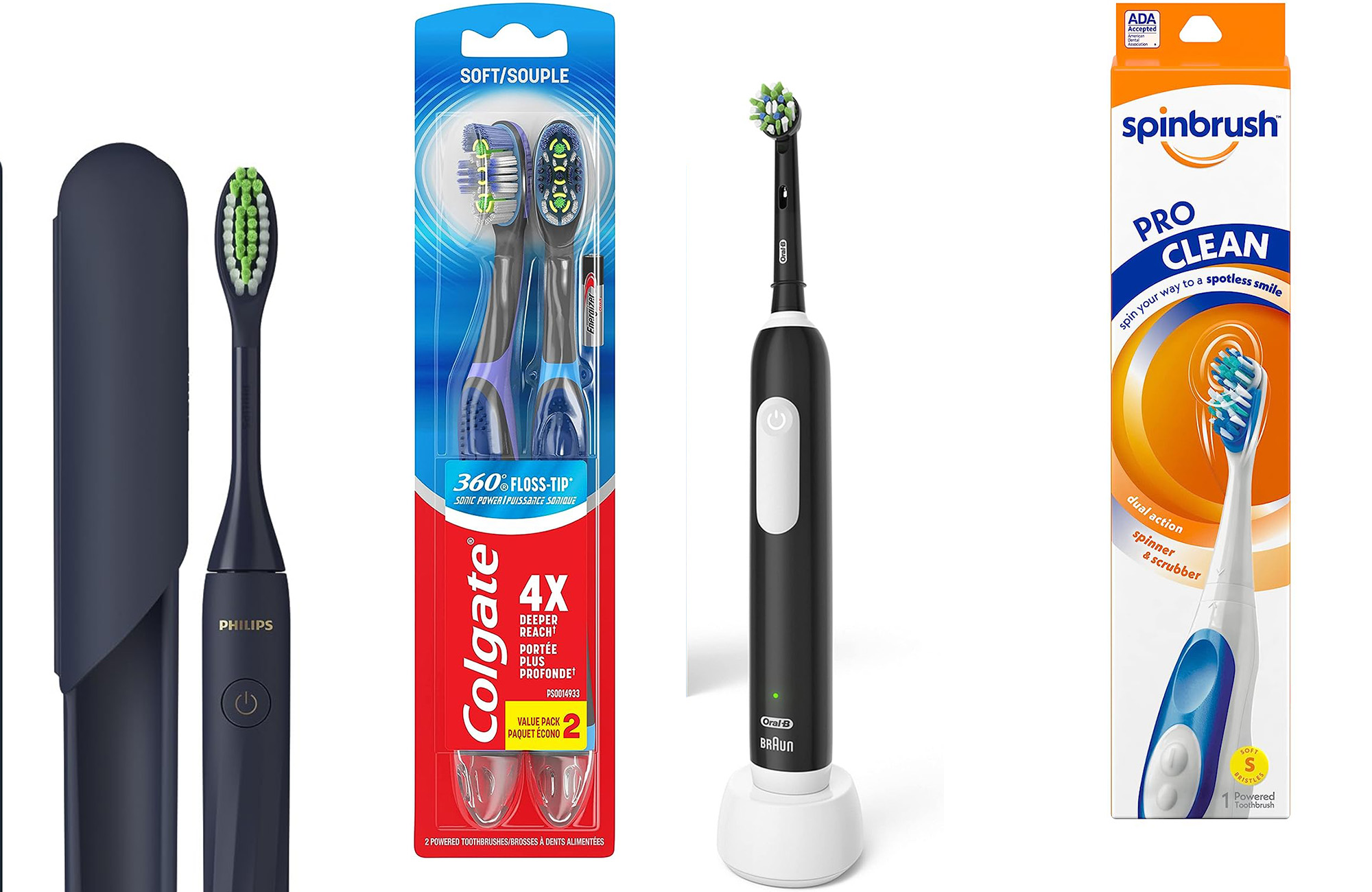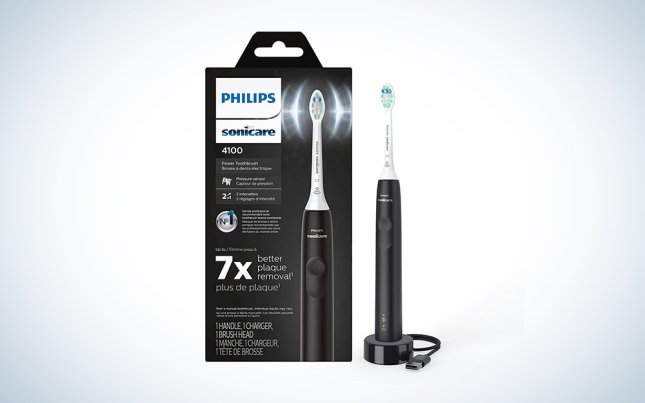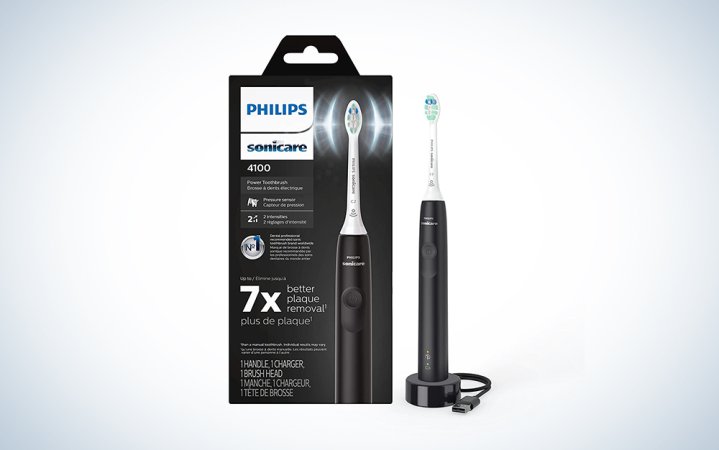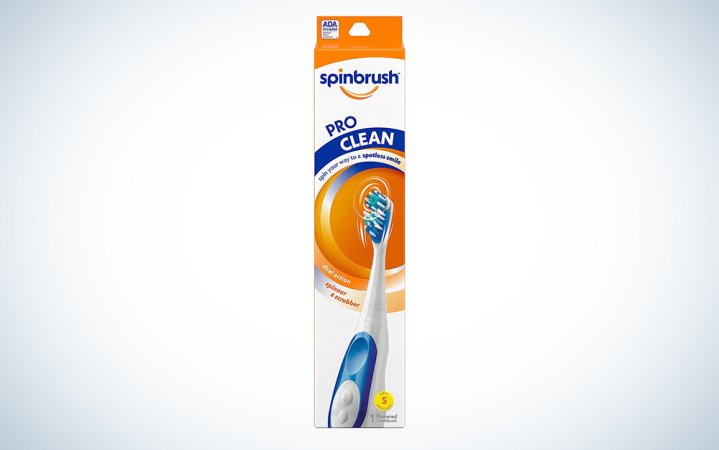We may earn revenue from the products available on this page and participate in affiliate programs. Learn more ›

If you’re using elbow grease to take actual grease off your chompers, you’re way behind the times! Dentists and dental hygienists recommend electric toothbrushes for deeper, more effective teeth-cleaning and better overall mouth health. But the fanciest electric toothbrushes can cost upwards of $300. Seems like a lot! We’ve got budget-friendly options here, so whether you’re buying your first or just wanting to upgrade to something better without breaking the bank, even the cheapest, least-advanced electric toothbrush is a tremendous improvement over manual brushing. And improved brushing means stronger teeth, healthier gums, better-smelling breath, less pain in sensitive areas, and less damage to the soft skin of your mouth, tongue, and gums. I’m not joking here: If you’re using a manual toothbrush, you’re living wrong. You need to go electric. You’ll be happy you did. But what to choose? Well, you’re looking for value, alongside overall effectiveness. And we did the hard work so you can go bonkers on your chompers. We’ve got the recommendations for the best cheap electric toothbrushes that will make you smile, and make that smile whiter.
- Best overall: Oral-B Pro 1000
- Best for travel: Philips One by Sonicare
- Best for kids: Oral-B Kids’ Electric Rechargeable Toothbrush
- Best for your tongue: Colgate 360 Floss Tip Battery Powered Toothbrush
- Best value: Philips Sonicare 4100
- Best budget: Arm & Hammer Spinbrush Pro Clean
How we chose the best cheap electric toothbrushes
Most of our staff have electric toothbrushes at home, so we first reached out and checked what everyone was using and how satisfied they were with their choice. Then we looked at what was being recommended by other reviewers, and finally we considered the user reviews and issues being reported in major commerce sites. Lastly, we looked at what the ADA—the American Dental Association—considers when it gives its Seal of Acceptance to a product. And, of course, we considered the cost: Our upper limit is $50. Using all that information, we came up with a list that is more insightful than an incisor and makes mountains out of molars. This list makes mouths happy, and that’s the tooth. No cap.
But, and it’s an important but, keep in mind that a toothbrush’s effectiveness is based on you using it correctly. You should be brushing for 2 minutes, twice a day, with about 30 seconds spent on each quadrant (upper left, upper right, lower left, lower right) of your teeth. Most people simply don’t do this, regardless of their brush. Electric toothbrushes often make it easier to keep track of this proper brushing by having 30-second vibration timers and 2-minute auto-shut-off timers, making it more likely you’ll actually brush your teeth enough, in addition to cleaning better moment-to-moment.
The best electric toothbrushes: Reviews & Recommendations
We all want to be chomping into apples well into our golden years. Get both of these universal dreams and still afford to retire with the best cheap electric toothbrushes.
Best overall: Oral-B Pro 1000
Best overall
Oral-B Pro 1000
Pros
- Cost-effective
- Name-brand brush replacements are cheap; generic are even cheaper
- Vibrating timer for proper brushing
- Durable and unlikely to break
Cons
- Only one speed setting
- 10-day battery life is a bit shorter than comparable Philips model
Specs
- Weight: 12.16 ounces (entire package)
- Battery Life: 10 days
- Brushheads Included: 1 circular brush head
- Accessories: travel case
Among a lot of top models, Oral-B’s Pro 1000 came out as our best overall, though it scrapes our upper limit of “cheap.” It would be considered a low-to-mid-level model in the Oral-B line, so it doesn’t have a lot of bells and whistles that the super expensive brushes do, but it does come with a travel case and the features that are most important: a pressure sensor and a two-minute timer. When you’re brushing, if you’re pushing too hard, the Oral-B Pro 1000 will weaken the oscillation of its brush head so that you don’t damage your teeth or gums. A pulse vibration will let you know when thirty seconds have elapsed so that you can move to a new quadrant of your mouth. At two minutes, the toothbrush will automatically turn off.
The Pro 1000 is compatible with Oral-B’s full line of brush heads. Oral-B name-brand brush heads tend to be cheaper than Philips Sonicare’s outside of sales. Generic brush heads are available at an even lower price, and do just as good a job. Don’t forget to change your brush head every three months.
The main drawback of the Oral-B line is that battery life is only about 75% that of Philips models, but it’s still a beefy 10 days. If you’re going on a short trip, use the included travel case without worrying about needing to charge the toothbrush. For longer trips, pack the corded charging stand. This particular Oral-B product even has the ADA Seal of Acceptance, meaning it met product standards for the American Dental Association. For giving an excellent clean at an extremely fair price without needless additional features, the Oral-B Pro 1000 is our best overall cheap electric toothbrush.
Best for travel: Philips One by Sonicare
Best for travel
Philips One by Sonicare
Pros
- Low cost of entry
- Slim, light travel case
- Shorter length
Cons
- Not rechargeable
- No advanced features
Specs
- Weight: 8.11 ounces (including case)
- Battery Life: 1 AAA battery lasts three months
- Brushheads Included: 3 standard brush heads
- Accessories: travel case
Every electric toothbrush is relatively easy to take when you travel. Most models come with a travel case, and most hold enough of a charge that you don’t need to worry about the batteries running out. However, they’re not exactly small, slim, or light to the extent that a manual brush is. If you want an electric toothbrush that’s specifically designed for travel, and one that will save you some money, the Philips One by Sonicare is that toothbrush.
For travel, it’s all about size and weight. The handle and brush are shorter than a home electric toothbrush, and the weight is almost half of what you might expect–and that includes the weight of the slim-profile travel case. The One still offers a built-in vibrating 2-minute timer with pulses for every 30 seconds to change quadrants. However, there’s no options for intensity or cleaning modes; there’s only one setting there.
There are two major drawbacks with the Philips One by Sonicare. The first is that it doesn’t have a rechargeable battery. Instead, it runs off a single AAA battery, which should last around three months (the same amount of time as the brush head). Secondly, in order to stay small, the Philips One by Sonicare has unique brush heads. Other Philips models’ brush heads and generic Philips-compatible brush heads won’t work with it. There are, however, generic One-specific brush heads available online.
If the increased portability outweighs these drawbacks, the Philips One by Sonicare is the best travel cheap electric toothbrush you can buy.
Best for kids: Oral-B Kids’ Electric Rechargeable Toothbrush
Best for kids
Oral-B Kids’ Electric Rechargeable Toothbrush
Pros
- Large, rubbery grip for small hands
- Four decorative stickers for kids to personalize their toothbrush
- Softer bristles for children’s mouths
- Compatible with all Oral-B brush heads
Cons
- Shorter battery life than adult models
- Your child will grow out of it and need a stronger model later
Specs
- Weight: 8.59 ounces (including charging stand)
- Battery Life: 5 days
- Brushheads Included: 1 extra-soft brush head
- Accessories: charging stand, decorative stickers
Kids have some of the dirtiest mouths around–and I’m certainly not talking about what they say. Most kids simply don’t like brushing their teeth. They find it time-consuming, annoying, and useless. Can’t blame them, they’re kids! Those teeth will come out soon enough! But the tongue and the gums and the roots, those need taking care of–and even those soon-to-be-given-to-a-fairy teeth too. Enter the Oral-B Kids’ Electric Rechargeable Toothbrush. There are tons of different variants of this model, most of which feature a popular Disney, Marvel, or Star Wars characters, and all of which retail for around $30.
This is a softer, gentler, kid-friendly version of our best overall model. The handle is larger, with a huge, rubbery grip that makes holding the brush easier for kids. The kids’ brush head has softer bristles, and the vibration power is weaker compared to the adult model. There’s still a timer–it uses fun little tunes as indicators instead of vibrations–and there’s still a pressure sensor. The decorative stickers allow kids to customize their toothbrush. There’s even an app that kids can run while they brush to encourage them to brush for the whole 2 minutes. They are rewarded with virtual objects for good brushing habits.
The main drawback of this model is it’s pretty juvenile. I can’t see a preteen still using this brush, so your child will eventually grow out of it even if the handle is still perfectly good. Also, kids under 3 years old shouldn’t be using electric toothbrushes. Instead, get extra-soft manual toothbrushes for toddler teeth. Another drawback is the battery isn’t as strong, lasting only five days, so you need to be vigilant about keeping the brush on the charging base.
However, when it comes to getting kids to brush more and brush longer, the Oral-B Kids’ Electric Rechargeable Toothbrush can be a game changer. For that reason, it’s the best cheap electric toothbrush for kids.
Best for your tongue: Colgate 360 Floss Tip Battery Powered Toothbrush
Best for your tongue
Colgate 360 Floss Tip Battery Powered Toothbrush
Pros
- Excellent tongue cleaning
- Small and light
- Battery outlasts brush
Cons
- Disposable brushes don’t have replaceable brush heads
- Bristles are a little harsh
Specs
- Weight: 1.44 ounces
- Battery Life: AAA battery lasts 6 months
- Brushheads Included: 1 built-in brush head with tongue cleaning back
- Accessories: 1 AAA battery included
The teeth are important, but too many people forget the tongue. Rechargeable electric toothbrushes with replaceable brush heads often have tongue-cleaning attachments that can help you clean away all those bad-breath-causing bacteria that accumulate all over your mouth’s middle muscle. But that’s a hassle, having to pop on and off different brush heads. For the price of about $5 each (plus a AAA battery twice a year), you can simply use the Colgate 360 Floss Tip Battery Powered Toothbrush.
Now, as a toothbrush, we can’t really recommend this model. It’s not that the clean you get isn’t good, it’s that it’s wasteful. These toothbrushes are all-in-one, not a handle with replaceable brush heads, meaning you have to throw the toothbrush out every three months if you’re following good brushing protocol. It just seems a bit unnecessary, especially when the battery lasts two brush cycles. However, the back of the Colgate 360 Floss Tip’s brush head contains a tongue cleaner. This rubber, ridged surface uses the vibration of the brush when turned on to scrape off all the scum that accumulates through the night or day and can cause bad breath. The tongue cleaner will last far longer than the brush bristles, meaning you can keep this around for a quick tongue clean without having to pop off or pop on a tongue-specific attachment to your main brush. I’d recommend switching brushes when the AAA battery dies, if you plan to use this solely as a tongue cleaner.
Because of its low price, convenience, and excellent tongue cleaning ability, the Colgate 360 Floss Tip Battery Powered Toothbrush is our best cheap electric toothbrush for your tongue (but not your teeth).
Best value: Philips Sonicare 4100
Best value
Philips Sonicare 4100
Pros
- Timer and pacer to ensure correct brushing
- Two intensity settings
- USB charging stand
- Pressure sensor
Cons
- No advanced features
- No travel case
Specs
- Weight: 8.64 ounces
- Battery Life: 14 days
- Brushheads Included: 1 Optimal Plaque Control brush head
- Accessories: none
Though we’re listing it under “best value,” the Philips Sonicare 4100 may as well be “best overall runner-up.” Like the Oral-B Pro 1000, it’s a low-mid-level model without the advanced features, but it cleans teeth wonderfully. It also costs about the same. It has the expected features of that type of model: a charging stand–though this one is USB–a pressure sensor, and a 2-minute timer with 30-second pace indicators, all through vibration. When compared directly to the Oral-B Pro 1000, it does have two big advantages: two different intensity settings (compared to the Oral-B Pro 1000’s one) and a longer battery life (by four days).
Where it comes up short is the lack of a travel case, which is a key accessory that you usually want to have. And, in general, branded Sonicare brush heads can be twice as expensive as Oral-B’s, so go generic, where the price of both goes down and evens out.
Ultimately, these drawbacks are what made the Sonicare 4100 “just” a good value and not the best overall. It retails at roughly the same price point as the Oral-B Pro 1000 ($50), and the clean quality is about the same. So, if a travel case isn’t a dealbreaker and you’re planning to get generic brush heads anyway, just go with whichever of those two models tickles your fancy or looks better next to your sink. Officially, the Sonicare 4100 is our best value cheap electric toothbrush.
Best budget: Arm & Hammer Spinbrush Pro Clean
Best budget
Arm u0026 Hammer Spinbrush Pro Clean
Pros
- Less than $10
- Both circular and vibrating bristles in one brush head
Cons
- A two-pack of replacement brush heads cost just as much as brush handle
- Only a marginal improvement over manual brushing
Specs
- Weight: 4.5 ounces
- Battery Life: 2 AA batteries last 4 to 6 weeks
- Brushheads Included: 1 dual brush head
- Accessories: none
As electric toothbrushes have exploded in popularity and the components that run them have gotten cheaper, we’ve seen a wave of budget models that come from companies not otherwise known for their electric toothbrushes. Arm & Hammer produced the Spinbrush line under their own brand and later launched a whole Spinbrush sub-brand of low-cost electric toothbrushes. The best among those looking to get into the electric toothbrush game for cheap is the Pro Clean.
The Pro Clean retails for $9, which is less than 20 percent of the expected cost of our overall best model. It’s a very minimal package, with only the handle and one attached brush head. There’s no charging stand, as the handle runs off two AA batteries, giving about 4 to 6 weeks of power (we always recommend rechargeables). The brush head itself— there’s only one type—has a dual design where the top part is a circular spinning brush head (like Oral-B) and the bottom is a vibrating straight brush head (like Philips). A replacement head will set you back about $4.
That’s really all there is to the Arm & Hammer Spinbrush Pro Clean. It’s a pretty good choice for Baby’s First Electric Toothbrush, but if you like it, there’s no reason not to upgrade to something better. However, for its cheapness alone, it is the best budget cheap electric toothbrush.
What to consider when choosing a cheap electric toothbrush
The consensus among dentists, hygienists, and other mouth-health professionals for years is that electric toothbrushes are simply better than manual brushes. They work more effectively, efficiently, and less harshly than traditional brushing. Both circular brush movement and brush vibration—the two methods used by electric toothbrushes—clear more plaque than sliding a static brush along the teeth and gum line. Most people don’t even manually brush correctly—they tend to ignore the gums and just get the tops of the teeth and brush far less than the recommended 2 minutes. It’s much easier to use an electric toothbrush since you simply move the brush head over all the spots on your teeth and gums and let the electric motions do the work. Electric toothbrushes also can have timers built-in that let you know when to move to a new part of your mouth. They can adjust pressure and vibrations to do different jobs (whitening, plaque removal, tongue-cleaning). While expensive models that won’t show up on this list have some advanced connectivity and logging features that you won’t find in the lower-end models, all of the features that affect the quality of clean are still present.
All that said, there are not a lot of variants in use-cases for electric toothbrushes—you’re gonna use it to brush your teeth! So the main thing to consider is features and price. The market for electric toothbrushes is dominated by two companies: Oral-B, owned by Proctor and Gamble, has a huge range of mouth-health products from floss and picks to mouthwash. Among those products are some excellent electric toothbrushes. Philips, a Dutch-based multinational electronics company that previously made appliances and televisions but now concentrates on health technology, may be best known for its electric “Norelco” shavers. Still, it’s also a leader among electric toothbrushes. Both companies produce excellent, reliable products along a whole range of price points, including ones we consider cheap. In truth, there’s rarely a “wrong” choice between the two. If there’s an edge between comparable models, it’s usually razor-thin.
We feel the features in our best overall and best value models—adaptable pressure sensors, timers—make the brushing process a bit more comfortable and easier to manage correct brushing technique. The lower-cost models that lack those features are still excellent devices, they simply put more onus on the user to time out their brushing sessions and manage pressure. Additionally, the rechargeable nature of the top models is really nice. Nothing more annoying that going to brush your teeth in the morning, finding your battery is dead, and not having replacements on hand. Imagine having to run to the drugstore with a dirty mouth! Shameful! However, if pure cost is your concern, you’ll still get a great clean with even the lowest-cost electric toothbrushes on our list.
FAQs
There’s no clear-cut winner. No reliable, clinical study has been done to prove whether the Oral-B method (rotating brush head) or the Sonicare method (vibrating brush head) is more effective at cleaning your teeth, but both have been proven more effective than manual brushing, especially if you brush for the full 2 minutes with 30 seconds in each quadrant that dentists recommend.
For a short time, the ADA (American Dental Association) did a “Seal of Acceptance” for dental products, saying that had been made to a certain standard set by the organization. Many Oral-B products carry this seal, as Oral-B is a US-based company. Being based in Europe, Philips didn’t submit any of their products for this and the seal has become less popular among dental products. Both major companies are widely recommended by dentists, and dentists always recommend electric toothbrushes over manual.
It’s not about the toothbrush; it’s about the brush head. Both Oral-B and Philips offer brush heads specifically designed for plaque removal. Cheaper generic equivalents are also available.
Unequivocally, yes. Now, you can over-brush your teeth with any kind of tooth brush, and damage your gums or worse. However, when used properly (2 minutes twice a day, 30 second per teeth quadrant), an electric toothbrush leaves a mouth with less plaque and bacteria than manual brushing.
Yes. Check the battery type of your electric toothbrush, however. If it’s a lithium metal or lithium-ion battery, pack it in your carry-on. Other battery types can go in either checked or carry-on luggage.
Final thoughts on the best cheap electric toothbrushes
- Best overall: Oral-B Pro 1000
- Best for travel: Philips One by Sonicare
- Best for kids: Oral-B Kids’ Electric Rechargeable Toothbrush
- Best for your tongue: Colgate 360 Floss Tip Battery Powered Toothbrush
- Best value: Philips Sonicare 4100
- Best budget: Arm & Hammer Spinbrush Pro Clean
I can’t stress enough how much you should upgrade from a standard manual toothbrush to an electric one. Seriously, please do it for a better brushing experience and better mouth health. Beyond that, there’s not a whole lot of difference in cleaning experience between most of the Philips and Oral-B models, so while we have our preferences, if you see a sale on a model not mentioned (making it cheaper than our recommendation), it’s probably a solid buy. The Spinbrush Pro Clean is good if you want to try before committing to something more expensive, but it is not as great a long-term solution. Regardless of what you choose, upgrade your smile within whatever your budget happens to be.









